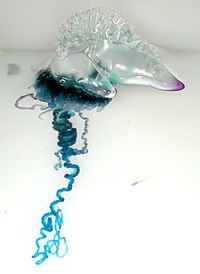
Laboratory and field insights into the dynamics and behavior of Argentine ants, Linepithema humile, feeding from hydrogels.
Sign Up to like & getrecommendations! Published in 2021 at "Pest management science"
DOI: 10.1002/ps.6368
Abstract: BACKGROUND Hydrogels that have absorbed a liquid containing a toxicant are a novel bait-delivery form for ant control. Here, we study the abilities of Argentine ant (L. humile) workers to imbibe liquid from hydrogels. We… read more here.
Keywords: ant species; field; feeding hydrogels; laboratory field ... See more keywords

Exclusion of Mediterranean ant species enhances biological control of the invasive mealybug Delottococcus aberiae in citrus.
Sign Up to like & getrecommendations! Published in 2023 at "Pest management science"
DOI: 10.1002/ps.7380
Abstract: BACKGROUND Delottococcus aberiae is an invasive mealybug that produces severe damage in Spanish citrus. This mealybug has established a mutualistic relationship with native Mediterranean ant species that may limit biological control of this pest. Herein,… read more here.
Keywords: biological control; control; aberiae; ant species ... See more keywords

Differences in Aggressive Behaviors between Two Ant Species Determine the Ecological Consequences of a Facultative Food-for-Protection Mutualism
Sign Up to like & getrecommendations! Published in 2018 at "Journal of Insect Behavior"
DOI: 10.1007/s10905-018-9695-8
Abstract: Ant-hemipteran mutualisms are widespread interactions in terrestrial food webs with far-reaching consequences for arthropod communities. Several hypotheses address the behavioral mechanisms driving the impacts of this mutualism, but relatively few studies have considered multiple ant… read more here.
Keywords: ant hemipteran; protection; ant species; aggressive behaviors ... See more keywords

Recruitment Rate of Nestmate in Six Tropical Arboreal Ants (Hymenoptera: Formicidae)
Sign Up to like & getrecommendations! Published in 2019 at "Journal of Insect Behavior"
DOI: 10.1007/s10905-019-09731-y
Abstract: We examined the recruitment rate of nestmates during prey capture in six arboreal ant species: Myrmicaria opaciventris, Platythyrea conradti, Crematogaster sp., Crematogaster clariventris, Tetramorium aculeatum, and Oecophylla longinoda. Termites and grasshoppers were used as prey.… read more here.
Keywords: arboreal; recruitment rate; ant species; prey ... See more keywords

Stability of Afromontane ant diversity decreases across an elevation gradient
Sign Up to like & getrecommendations! Published in 2019 at "Global Ecology and Conservation"
DOI: 10.1016/j.gecco.2019.e00596
Abstract: Abstract As the need to better understand the ecology of hotspots of endemism intensifies, the insurance hypothesis is drawing increasing attention from policy-makers and scenario-planners. The hypothesis states that biodiversity increases ecosystem stability. When species… read more here.
Keywords: altitude; stability; ant species; ecology ... See more keywords

The social supergene dates back to the speciation time of two Solenopsis fire ant species
Sign Up to like & getrecommendations! Published in 2020 at "Scientific Reports"
DOI: 10.1038/s41598-020-67999-z
Abstract: Colony social organization of multiple Solenopsis fire ant species is determined by a supergene with two haplotypes SB and Sb, which are similar to X/Y sex chromosomes. The ancestral monogyne (single-queen) social form has been… read more here.
Keywords: supergene; ant species; solenopsis; solenopsis fire ... See more keywords

Introduced ant species occupy empty climatic niches in Europe
Sign Up to like & getrecommendations! Published in 2021 at "Scientific Reports"
DOI: 10.1038/s41598-021-82982-y
Abstract: Exploring shifts in the climatic niches of introduced species can provide significant insight into the mechanisms underlying the invasion process and the associated impacts on biodiversity. We aim to test the phylogenetic signal hypothesis in… read more here.
Keywords: empty climatic; ant species; species europe; introduced species ... See more keywords

Metastriate Ixodid Life Stages Protected from Predatory Ants in Texas
Sign Up to like & getrecommendations! Published in 2019 at "Environmental Entomology"
DOI: 10.1093/ee/nvz097
Abstract: Abstract Multiple predatory ant species, including the red imported fire ant, Solenopsis invicta (Buren) (Hymenoptera: Formicidae), have been reported to attack ixodids (Ixodida: Ixodidae), but evidence has largely been circumstantial. When living lone star tick,… read more here.
Keywords: metastriate; predatory ants; ixodid life; ant species ... See more keywords

Structure of ant assemblages on street trees in urban Busan, Korea
Sign Up to like & getrecommendations! Published in 2020 at "Entomological Research"
DOI: 10.1111/1748-5967.12415
Abstract: Street trees planted in urban areas are one of the smallest urban green habitats; however, their role as a valuable refuge for local biota is poorly understood. The aim of this study was to investigate… read more here.
Keywords: street; ant species; assemblages street; street trees ... See more keywords

First Records of Two Strumigenys Ant Species (Hymenoptera, Formicidae) from Bulgaria
Sign Up to like & getrecommendations! Published in 2020 at "Sociobiology"
DOI: 10.13102/sociobiology.v67i2.4963
Abstract: The Strumigenys ant species (Hymenoptera: Formicidae) are poorly studied in Bulgaria due to their small size and cryptic lifestyles. To date, only one species, S. baudueri (Emery, 1875), has been reported from a collecting site… read more here.
Keywords: ant species; first records; strumigenys ant; hymenoptera formicidae ... See more keywords

Edge effects on ant diversity and functional composition in a forest fragment in the Central Amazon
Sign Up to like & getrecommendations! Published in 2023 at "Sociobiology"
DOI: 10.13102/sociobiology.v70i1.7657
Abstract: The process of human-induced forest fragmentation increases the degree of isolation and causes biodiversity loss. Abrupt changes occur mainly near the edge of the fragment, where the average temperature is relatively higher and the humidity… read more here.
Keywords: composition; distance; diversity functional; ant species ... See more keywords